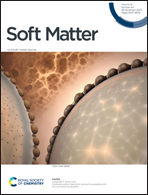Inertial effect on evasion and pursuit dynamics of prey swarms: the emergence of a favourable mass ratio for the predator–prey arms race†
Abstract
We show, based on a theoretical model, how inertia plays a pivotal role in the survival dynamics of a prey swarm while chased by a predator. With the varying mass of the prey and predator, diverse escape patterns emerge, such as circling, chasing, maneuvering, dividing into subgroups, and merging into a unitary group, similar to the escape trajectories observed in nature. Moreover, we find a transition from non-survival to survival of the prey swarm with increasing predator mass. The transition regime is also sensitive to the variation in prey mass. Further, the analysis of the prey group survival as a function of predator-to-prey mass ratio unveils the existence of three distinct regimes: (i) frequent chase and capture leading to the non-survival of the prey swarm, (ii) an intermediate regime where competition between pursuit and capture occurs, resembling an arms race, and (iii) the survival regime without the capture of prey. Interestingly, our study demonstrates the existence of a favourable predator–prey mass ratio for coexistence of both prey and predator in an ecosystem, which agrees well with the field studies.



 Please wait while we load your content...
Please wait while we load your content...